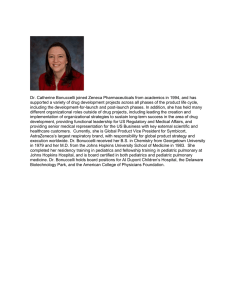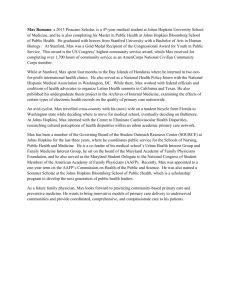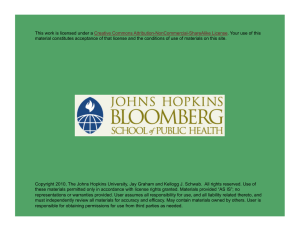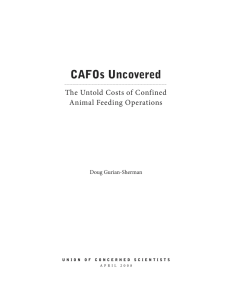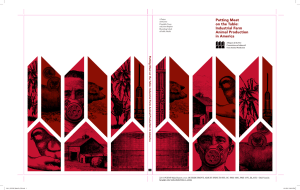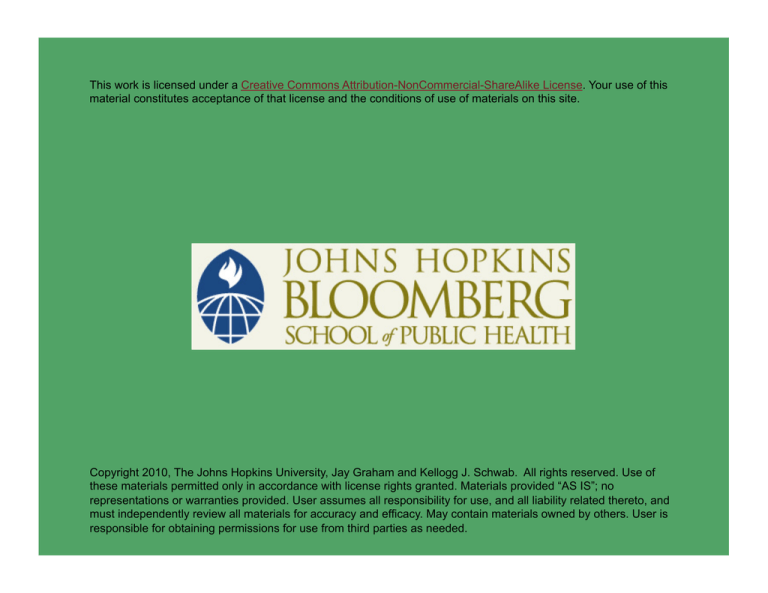
This work is licensed under a Creative Commons Attribution-NonCommercial-ShareAlike License. Your use of this
material constitutes acceptance of that license and the conditions of use of materials on this site.
Copyright 2010, The Johns Hopkins University, Jay Graham and Kellogg J. Schwab. All rights reserved. Use of
these materials permitted only in accordance with license rights granted. Materials provided “AS IS”; no
representations or warranties provided. User assumes all responsibility for use, and all liability related thereto, and
must independently review all materials for accuracy and efficacy. May contain materials owned by others. User is
responsible for obtaining permissions for use from third parties as needed.
The Ins and Outs of IFAP:
A Public Health Perspective
Jay P. Graham, PhD, MBA
Kellogg J. Schwab, PhD
Johns Hopkins University
Jay Graham
American Academy for the
Advancement of Science
Diplomacy Fellow with the U.S.
Agency for International
Development
CLF Research Fellow
PhD from JHSPH
Co-authored publications for
FAO on avian influenza
Consultant to the Pew
Commission on Industrial
Farmed Animal Production
3
Kellogg Schwab
Associate Professor, Environmental Health
Sciences
Director, Johns Hopkins Center for Water and
Health
Joint appointments in the Department of
Molecular Microbiology and Immunology and
the Johns Hopkins University Department of
Geography and Environmental Engineering
Interests focus on transport of pathogens in the
environment
Collaborations with CDC on investigations of
foodborne outbreaks of viral gastroenteritis
4
Section A: Managing Food Animal Waste in the
United States: A Public Health Perspective
Jay P. Graham, PhD, MBA
Johns Hopkins University
Topics in This Lecture
Industrial food animal production (IFAP)
Feed inputs
Waste outputs from IFAP: changes in quantity, quality, and
distribution
Waste management policies
Public health implications (Dr. Kellogg Schwab)
Potential solutions
6
Industrial Food Animal Production (IFAP)
Semi-vertically integrated industry
- Example: broiler industry
Integrators, i.e., companies
- Control hatcheries, breeder flocks, feed mills, and
processing plants
-
Determine feed inputs
Farmers
- Generally receive a one-year contract to raise the
broilers
-
-
-
Heavily mortgaged
Own the waste (excreta and mortalities)
Paid a set amount per pound live weight
7
Growth of Industrial Food Animal Production
8
High-Density Confinement
Fecal-oral route of disease very important here!
Image source: USDA.
9
Geographic Concentration of Chicken Production
Chicken processing plants, 1949
Dots represent plants processing
50,000 or more chickens annually
Major chicken production areas, 1982
1 dot = 750,000 or more broilers
Source: USDA.
10
AFOs and CAFOs
Animal feeding operations (AFOs)
- Lot or facility where animals will be stabled or confined
-
No sustained forage growth
Concentrated animal feeding operations (CAFOs)
- Have an equivalent of 1,000 animal units
Animal unit is 1,000 pounds of live weight
125,000 broiler chickens, 2,500 swine, 700 dairy cattle
15,500 AFOs out of 238,000 are now CAFOs
- CAFOs provide 43 percent of animals raised for food in the U.S.
11
Total Annual U.S. Food Animal Production
Cattle
32,734,000
Calves
847,000
Sheep
2,844,000
Hogs
Broilers
8,788,281,000
Turkeys
254,455,000
Total
Source: USDA. (2005).
103,584,000
9,182,745,000
12
Summary of Important Considerations
Number of animals
Location of production facilities
Methods of production, including density of animals
Animal welfare issues
Disposal of waste
13


